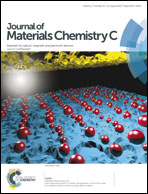Hydrogen-bonded supercoil self-assembly from achiral molecular components with light-driven supramolecular chirality†
Abstract
Supercoils self-assembled from two achiral molecular components have been synthesized in order to better understand the structure and functionality of this chiral supramolecular association. The two-component synthon is a complementary hydrogen-bond pair having one melamine core and three photoaddressable azobenzene units, which self-assembled into long and helical fibers with intrinsic conformational chirality. Hierarchical self-assembly was presented where one-dimensional helixes bundled into a higher order optically active supercoil structure, leading to spontaneous chiral symmetry breaking and amplification of chirality. Circular dichroism (CD) spectroscopy, transmission electron microscopy (TEM) and atomic force microscopy (AFM), as well as X-ray diffraction (XRD) techniques reveal the chiral nature of the assembly. Accordingly, a plausible mechanism of a hierarchical self-assembly process has been proposed, which presents a valid approach for constructing supramolecular chirality from achiral molecular building blocks through non-covalent interactions. The morphology and chirality of the supercoils demonstrate photoresponsivity, which is induced from the photoisomerization of the azobenzene components within the self-assembled nanostructures. Furthermore, the supercoil is a highly proton-conductive material because of its highly ordered structure and the proton transfer between the H-bonded melamine and azobenzene units within this two-component association.


 Please wait while we load your content...
Please wait while we load your content...